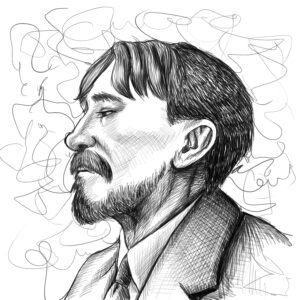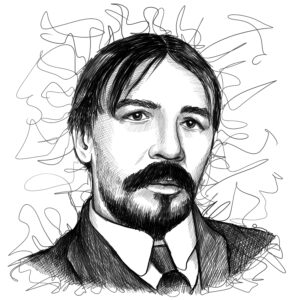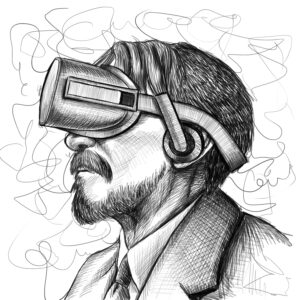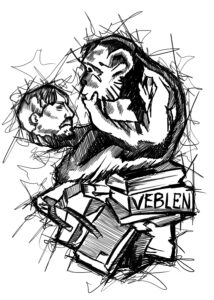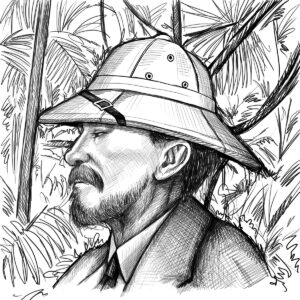 Like the explorer Henry Stanley searching for Dr. Livingstone in the African jungle, I, too, have spent years searching for the real Thorstein Veblen. Veblen was a prominent American economist who lived from 1857 to 1929. Today, he is remembered only by a small tribe of academics, primarily economists of the Institutional and Evolutionary schools of economic thought. I was fortunate to be introduced to Veblen’s work as an undergraduate by my economics professor, David Hamilton.
Like the explorer Henry Stanley searching for Dr. Livingstone in the African jungle, I, too, have spent years searching for the real Thorstein Veblen. Veblen was a prominent American economist who lived from 1857 to 1929. Today, he is remembered only by a small tribe of academics, primarily economists of the Institutional and Evolutionary schools of economic thought. I was fortunate to be introduced to Veblen’s work as an undergraduate by my economics professor, David Hamilton.
After college, I could never understand why such a brilliant mind—one that offered a science-based perspective on human behavior and its socioeconomic impacts—seemed to have disappeared both inside and outside academia.
An Inconvenient Economist
Veblen was unlike any other economist I encountered in my mainstream economic studies. Whereas conventional economics relies on a quantitative structure, Veblen argued that human instincts—the good, the bad, and the ugly—play a defining role in socioeconomic behavior. He introduced a novel perspective on the forces of human nature and nurture, applying it to economics as a broader framework for understanding how humans provide for their fundamental needs.
Despite Veblen’s science-based insights, mainstream economics continues to embrace ideological and quasi-theological conceptions of human nature, most notably the notion of homo economicus—the rational, self-interested “economic man.” For his intellectual heresies against economic orthodoxy, Veblen paid dearly, both personally and professionally.
Outside academic economics, Veblen is largely unknown. To the extent that he is remembered, it is often for coining the term conspicuous consumption—a phrase lifted from his first book, The Theory of the Leisure Class, but taken out of its broader context.
In Search of Veblen’s Holy Grail
After a career spent demystifying high-tech products for broader, non-technical audiences, I took up the challenge of understanding the “big picture” of Veblen’s work and communicating it beyond academia. A century after his death, no one has yet cracked the code for interpreting, synthesizing, and effectively explaining his insights to the general public. I suspected that Veblen’s work was even more relevant today than it was in his own time.
My journey led me through the dense jungles of academic literature. Over the past decade, I have explored the vast universe of research on Veblen, most of it produced through the narrow lens of specific disciplines. The majority of this work has come from economics and sociology, with additional insights from anthropology, psychology, and philosophy.
Veblen was both a credentialed economist and a philosopher, yet he drew heavily from a broad range of disciplines, including the biological, social, and physical sciences. Despite this, most academic research on Veblen has remained confined to economics and the social sciences. This disciplinary compartmentalization, while valuable in its own right, has fragmented the understanding of his work. Each field examines Veblen through its own principles, often zooming in on narrow aspects without integrating insights from other disciplines.
The Missing Link
The more I studied Veblen’s body of work, the more I felt that something crucial was missing. At best, he was an uneasy fit within the social sciences, particularly in economics. While anthropologists, sociologists, and philosophers provided additional context for his ideas, their contributions still felt incomplete.
Evolutionary economists introduced Darwin’s theory of evolution to economics as a challenge to the discipline’s static models. Yet Veblen’s use of biological concepts—such as instincts and behaviors like predation, emulation, prowess, and habits of thought—went well beyond Darwinian evolution.
Human Biology, Psychology, and Zoology
A friend recommended I read Strangers to Ourselves: Discovering the Adaptive Unconscious by Timothy Wilson. In it, Wilson explores how our powerful and sophisticated unconscious mind operates beneath our awareness, shaping our perceptions and decisions. He explains that much of what drives us is inaccessible even to introspection.
This book led me down a new path in my Veblen research—one that incorporated human biology, psychology, and zoology. Drawing insights from works such as Behave: The Biology of Humans at Our Best and Worst by Robert Sapolsky, Before You Know It: The Unconscious Reasons We Do What We Do by John Bargh, and The Naked Ape: A Zoologist’s Study of the Human Animal by Desmond Morris, I began to see Veblen’s work in a new light.
Sapolsky, in particular, made a compelling case that human behavior is shaped by a dynamic interplay between biology and environmental context—where environment encompasses everything from culture to physical surroundings. Understanding this complex system requires an approach akin to chaos theory, where patterns emerge from seemingly unrelated variables.
The Whole Is Greater Than the Sum of Its Parts
A proverbial light bulb went off in my brain. Veblen’s work cannot be fully understood within the confines of a single academic discipline—or even within an entire category like the social sciences. To grasp the full scope of his insights, I realized that the whole of his work is greater than the sum of its parts.
Don’t get me wrong—the scholars who have explored Veblen from their respective disciplines have laid valuable groundwork. However, their contributions often exist in isolation, disconnected from other relevant fields. What is needed is an approach that synthesizes these individual insights into a mosaic—a holistic understanding of Veblen’s work that transcends disciplinary silos.
Veblen’s vision of human socioeconomic behavior can only be fully appreciated through an interdisciplinary framework that integrates biology, social science, and the physical sciences.
This transdisciplinary perspective is like gaining X-ray vision—a tool for seeing through the invisible ideological force fields that shape our economic mythologies, political ideologies, and theological assumptions about human nature.
The result of my journey is this blog, where I attempt to present Veblen’s work as a coherent, interconnected whole. When viewed this way, his pioneering insights emerge as more relevant and powerful than ever—perhaps even more so than in his own time, a century after his death.
